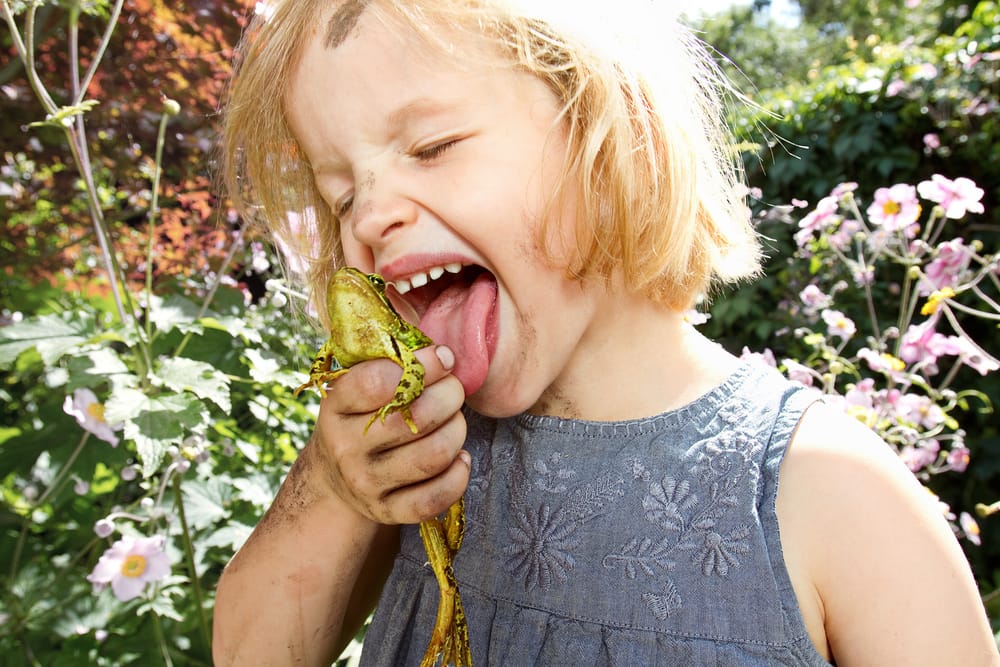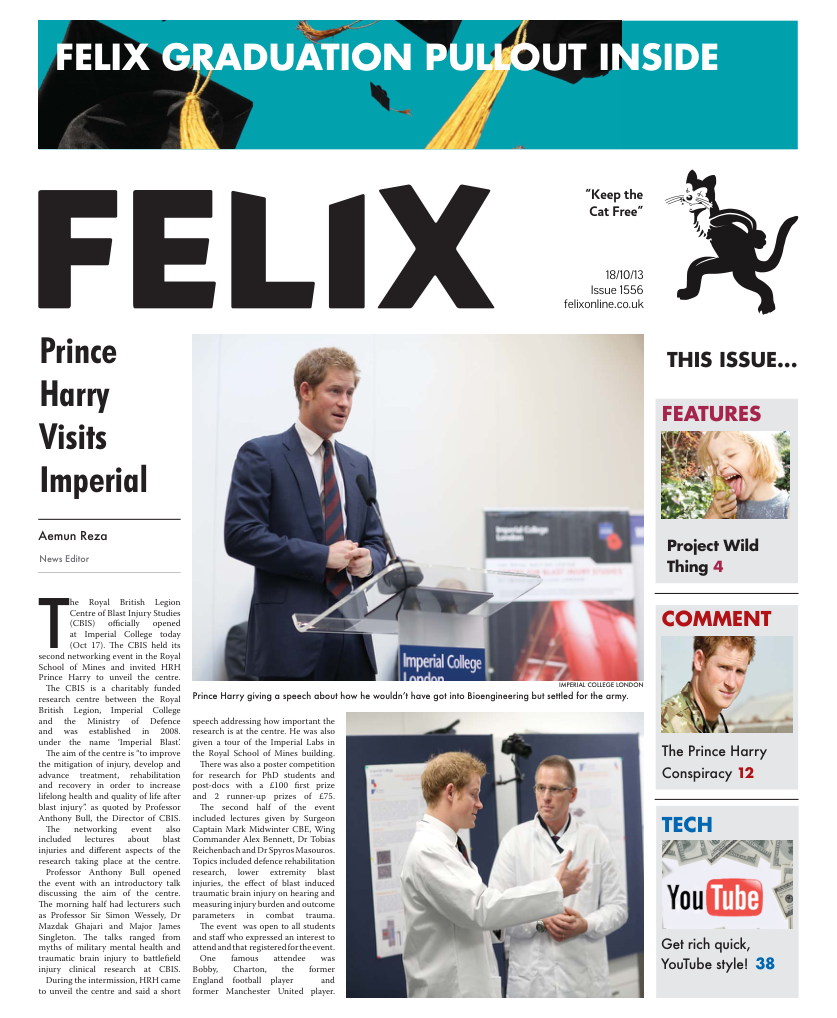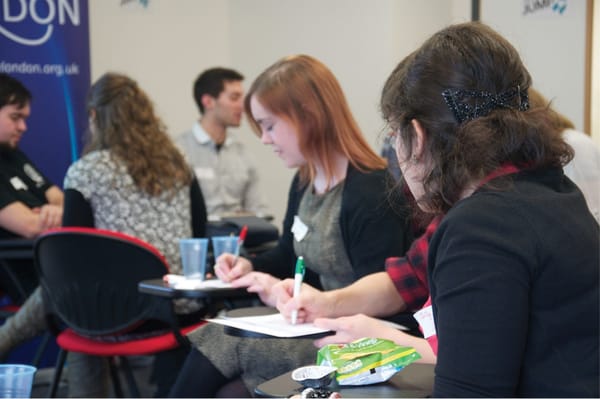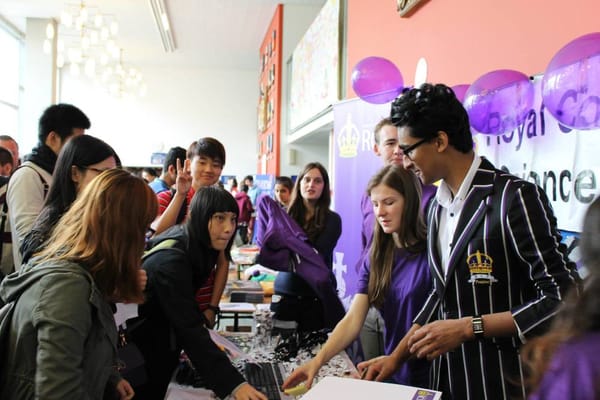Project Wild Thing - Coming to an Imperial Cinema near you...
Project Wild Thing opens in Cinemas nationwide on Friday 25th October. It will be screening at Imperial Cinema on Friday 25th October at 5pm. Tickets £5 students / £7 others available online at bit.ly/wildthingimperial

David Bond is a worried man. When he was a child, he spent his time outdoors in the natural world, but now all his children do is stare at screens and obsess with big brands. He sets out to change things, appointing himself Marketing Director for Nature. This witty and irreverent documentary follows his antics as he attempts to launch a national marketing campaign to get children back enjoying the great outdoors. Described as “Like David Attenborough and Morgan Spurlock got drunk and had a baby” by one watcher at the Sheffield Doc Fest where the film premiered this summer, it’s sure to be an interesting watch.
Felix caught up with the man himself, fresh out of the BBC newsroom where he’d been preparing an edit of the film for Newsnight.
The film release is quite soon now, so how are the preparations going?
It’s going really well. We’ve got over 50 cinema screenings, which for a documentary is really an amazing release, and we’re going out all over the country, which is really amazing. We’re really pleased to be playing at Imperial. We’ve had a couple of interns working on the film who were at Imperial, so we feel quite connected. Noah Baker and Andrew Mehigan were both interns with us. So that’s one of the reasons we rang Imperial Cinema – “you should screen it as your guys have been working on it”.
The preparations are good, we’ve got loads of events going on at the different screenings. It’s been a hell of a ride. It’s been 3 years in the making, so it’s been pretty terrific.
I love the style of the trailer, the idea of socking it to the big brands in a language they understand. Since you are setting yourself up as the Marketing Director for Nature, what’s your elevator pitch?
It’s the ultimate product. It’s fun, it’s free and it’s good for you. And there’s almost nothing in the world you can say that about... except maybe sex, although that’s not always true for sex even.
Why did you take the approach of a big brand to the idea?
I’ve got two young kids, so I noticed that they are much more into the telly and computer games and toys than going outdoors. When I get them outdoors, they really love it. As a product, they love consuming it and they really enjoy it, but they don’t choose it, and that struck me as probably a branding problem. I wanted to compete with the brands that they do choose, even though they don’t enjoy them as much as going outdoors. They do choose Disney and Nintendo and Apple and CBeebies. Partly that’s because the stuff that those guys have got to offer is not necessarily good for them but quite addictive, but its partly because there’s a lot of advertising and branding that goes on, around, well in the case of Disney they own Marvel now, so everything my son’s got is Spider Man now – he’s kind of saturated with the Marvel Brand, so I guess I wanted to see what it would look like if I tried to saturate his life with the nature brand, whether it would have an effect.
When you were doing all this, did you find anything very surprising with your experience?
There’s some things that people think about nature that really aren’t true. People think that it’s the preserve of the wealthy, the middle classes, to go frolicking in nature. Actually we discovered that the disconnection of children from nature cuts across class, wealth and geography. You’d like to think that people in rural places are really well connected with nature and that people in cities aren’t, but that’s actually not true, in fact it’s slightly the other way round according to a study published on Wednesday by the RSPB.
Also, the discovery how universally loved it is as a product, how weirdly we don’t choose it as it has been displaced by these other better marketed products.
Those were the two big things that struck me – that nature is a product, a thing to go and consume, (there’s something weird about describing it as a product because it’s free and we’re part of it in a sense), but at the same time, being able to set it up and talk about it as an option for enjoyment. A kid would have a pie chart for what they do, and nature, the outdoors, would be one chunk of that. And I guess what I saw my job as doing was to try and grow that segment of the pie chart. And I just loved discovering just how much children love it, and adults of course. Everybody loves being outdoors, but people don’t choose it, and I’m convinced that’s a kind of marketing and branding problem.
This film has got quite a wide release for a documentary? How did you manage it?
We came up with the idea, and raised money from various sources, including BritDoc and Channel 4, and some private places, including the National Trust, the RSPB. We were tremendously lucky in raising the money to release it. In terms of getting the release, it’s just got to go down well. We played it at the big European documentary film festival in Sheffield (Sheffield Doc Fest). Lots of buyers came and saw it there, it was a packed house, and people reacted really well. It’s funny because people laugh when they watch it. I don’t think people were expecting it to be funny. I think we were quite lucky that we managed to pull that off, because it’s a really serious issue about how we are going to connect with the environment in the future, and whether our kids are going to give a toss whether species die out or not. So it’s a heavy subject and it’s also got an element of heaviness in it because it’s about what we ought to do, it’s got a bit of a government information feel to it – that you ought to eat 5 a day, you ought not to smoke, you ought to go outdoors, but I think we managed to avoid it feeling like a film that does either of those two things, either that is really heavy about the issue, or feels really preachy, by just having a lot of fun making it. And also cooking up this slightly crazy caper where I tried with no money and not very much time, to do a nationwide marketing campaign for a nonexistent product which we cooked up. Well, it’s out there, but we employed ourselves as it’s marketing directors.
Apart from you, who’s the team behind it?
It’s me and my longtime producer who I worked with on a number of films, Ashley Jones. Then the core team is Lorraine O’Donovan and some camera people and editors who come and go, but really the core team is just three of us. We have some researchers, which is why we worked with people from Imperial, although Andrew was also assistant producing. And then now, obviously, we’ve got publicists. So it’s a really long and difficult process, but the core team is really quite small.
What would you say inspired your documentary style?
I really love documentaries that are irreverent, and fell like an adventure. I really like what Morgan Spurlock and Michael Moore do, and I’m really influenced by that kind of campaigning, active film making. I’m a big fan of the Yes Men. On TV I really love Louis Theroux. In terms of the look, we’re just so lucky with cameras. We shot it all on a C300 camera, which is around £10,000. Ten years ago it would have been a £200,000 camera. And then of course we chose the visual style of the animations – there are animated sequences which are very lively and quite humorous and light, so rather than going through a series of documentary scenes to explain the scientific benefits of nature, we just go into a 90 second animation about it.
What is the big goal of what you want this to achieve with this film?
The creation of this film has brought into existence this outfit called the Wild Network. It’s a network of organisations and individuals who all want to campaign to get children more connected with the outdoors. It includes the National Trust, the RSPB, the NHS some big brands like Arla and Lurpak, and advertising agencies, and 300 other organisations. They are going to campaign to reconnect children with nature, and they are using the film as an awareness-raiser. So what I hope to achieve is that lots of people see the film, and start thinking about how little time British children spend outdoors. And just by thinking about that and being aware of it, I’m pretty hopeful it will help it to change it. And especially with the Wild Network following that up with recommended things, so they are going to announce to ask every British child to try and swap half an our of screen time for outdoor time every day. It’s basically the Wild Network saying “Go Watch the film, but then try and swap a bit of the time we all spend staring at screens”. We support that, but the film doesn’t ask anything of you other than to enjoy it and watch it.
Imperial is a Science and Technology University, so we love our screens. What would you say to Imperial students?
I think all the Imperial students I’ve met are very well balanced. They interact with technology at their work and their study because it’s a fundamental part of what they do. But maybe the ones we’ve spent time with are the ones who are interested in the issue and therefore more connected with the outdoors? I’d say, just watch the film. If you come and see it – obviously it’s playing at Imperial – what we’ve found is that people don’t necessarily make some massive change, but it’s just the awareness of the overwhelming scientific evidence that’s out there now to say how good it is for you to spend some time connected to the outdoors. I mean, the science is really compelling, it’s good for your blood pressure, your stress hormones, patients with a view of nature recover faster than patients with an urban view, exam students who study with a view of nature perform better in exams than those who study without. There’s a huge and growing body of peer-reviewed scientific evidence that you should get yourself a dose of nature, so I’d say to Imperial students, if you life has become balanced away from that and into a very serene heavy existence, don’t stress about it, but at least find out about it, find out what you are missing out on.
I don’t think screens are bad for you, but they displace something that’s really, really good for you.
You are a film maker, so I can’t resist asking, 35mm or digital?
We shot this on the C300, which is digital. But I’ve shot on film before and I love it. The trouble with film is that when you press the record button on the camera you can just hear the money burning. It’s so expensive shooting on film, and the joy of digital is that you can do lots of takes. We shot 180 hours to make this 90 minute documentary. If you did that on film, you’d have to have a very, very, very big budget. So I think, as a documentary maker, my answer is digital.
Finally, how did the frog taste?
It actually tastes pretty good. Once you get over the texture it has quite a nice earthy, maybe even mushroomy kind of flavour. It wasn’t bad... it was a little bit wet and cold, which is always a bit of downer when you are licking something , but it was pretty good.
We hired it from an outfit called Celebrity Amphibians, and that frog had been on Casualty.







